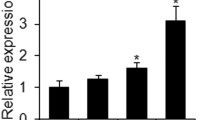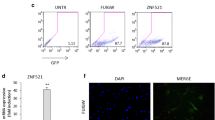Abstract
Dexamethasone (Dex) stimulates the differentiation of mesenchymal progenitor cells into adipocytes and osteoblasts. However, the mechanisms underlying Dex-induced differentiation have not been clearly elucidated. We examined the effect of Dex on the expression and activity of Wnt/β-catenin signal-related molecules in a clonal mesenchymal progenitor cell line, ROB-C26 (C26). Dex induced the mRNA expression of Wnt antagonists, dickkopf-1 (Dkk-1), and Wnt inhibitory factor (WIF)-1. Immunocytochemical analysis showed that the downregulation of β-catenin protein expression by Dex occured concomitantly with the increased expression of the PPARγ protein. Dex decreased phosphorylation of Ser9-GSK3β and expression of active β-catenin protein. To examine the effects of Dex on Wnt/β-catenin activity, we used immunocytochemistry to analyze TCF/LEF-mediated transcription during Dex-induced adipogenesis in Wnt indicator (TOPEGFP) C26 cells. Our results demonstrated that Dex repressed TCF/LEF-mediated transcription, but induced adipocyte differentiation. Treatment with a GSK3β inhibitor attenuated Dex-induced inhibition of TCF/LEF-mediated transcriptional activity, but suppressed Dex-induced adipocyte differentiation, indicating that adipocyte differentiation and inhibition of Wnt/β-catenin activity by Dex are mediated by GSK3β activity. Furthermore, β-catenin knockdown not only suppressed Dex-induced ALP-positive osteoblasts differentiation but also promoted Dex-induced adipocytes differentiation. These results suggest that inhibition of β-catenin expression by Dex promotes the differentiation of mesenchymal progenitor cells into adipocytes.






Similar content being viewed by others
References
Bellows CG, Aubin JE, Heersche JN (1987) Physiological concentrations of glucocorticoids stimulate formation of bone nodules from isolated rat calvaria cells in vitro. Endocrinology 121:1985–1992
Bellows CG, Ciaccia A, Heersche JN (1998) Osteoprogenitor cells in cell populations derived from mouse and rat calvaria differ in their response to corticosterone, cortisol, and cortisone. Bone 23:119–125
Bennett CN, Ross SE, Longo KA, Bajnok L, Hemati N, Johnson KW, Harrison SD, MacDougald OA (2002) Regulation of Wnt signaling during adipogenesis. J Biol Chem 277:30998–31004
Beresford JN, Bennett JH, Devlin C, Leboy PS, Owen ME (1992) Evidence for an inverse relationship between the differentiation of adipocytic and osteogenic cells in rat marrow stromal cell cultures. J Cell Sci 102:341–351
Beresford JN, Joyner CJ, Devlin C, Triffitt JT (1994) The effects of dexamethasone and 1,25-dihydroxyvitamin D3 on osteogenic differentiation of human marrow stromal cells in vitro. Arch Oral Biol 39:941–947
Canalis E, Mazziotti G, Giustina A, Bilezikian JP (2007) Glucocorticoid-induced osteoporosis: pathophysiology and therapy. Osteoporos Int 18:1319–1328
Cho SW, Yang JY, Sun HJ, Jung JY, Her SJ, Cho HY, Choi HJ, Kim SW, Kim SY, Shin CS (2009) Wnt inhibitory factor (WIF)-1 inhibits osteoblastic differentiation in mouse embryonic mesenchymal cells. Bone 44:1069–1077
Christodoulides C, Laudes M, Cawthorn WP, Schinner S, Soos M, O’Rahilly S, Sethi JK, Vidal-Puig A (2006) The Wnt antagonist Dickkopf-1 and its receptors are coordinately regulated during early human adipogenesis. J Cell Sci 119:2613–2620
Christodoulides C, Lagathu C, Sethi JK, Vidal-Puig A (2009) Adipogenesis and WNT signaling. Trends Endocrinol Metab 20:16–24
Cui Q, Wang GJ, Balian G (1997) Steroid-induced adipogenesis in a pluripotential cell line from bone marrow. J Bone Joint Surg Am 79:1054–1063
Deng J, Hua K, Caveney EJ, Takahashi N, Harp JB (2006) Protein inhibitor of activated STAT3 inhibits adipogenic gene expression. Biochem Biophys Res Commun 339:923–931
Farmer SR (2006) Transcriptional control of adipocyte formation. Cell Metab 4:263–273
Gimble JM, Robinson CE, Wu X, Kelly KA (1996) The function of adipocytes in the bone marrow stroma: an update. Bone 19:421–428
Grigoriadis AE, Heersche JN, Aubin JE (1988) Differentiation of muscle, fat, cartilage, and bone from progenitor cells present in a bone-derived clonal cell population: effect of dexamethasone. J Cell Biol 106:2139–2151
Grigoriadis AE, Heersche JN, Aubin JE (1990) Continuously growing bipotential and monopotential myogenic, adipogenic, and chondrogenic subclones isolated from the multipotential RCJ 3.1 clonal cell line. Dev Biol 142:313–318
Hamidouche Z, Hay E, Vaudin P, Charbord P, Schule R, Marie PJ, Fromigue O (2008) FHL2 mediates dexamethasone-induced mesenchymal cell differentiation into osteoblasts by activating Wnt/beta-catenin signaling-dependent Runx2 expression. FASEB J 22:3813–3822
Hayashi K, Yamaguchi T, Yano S, Kanazawa I, Yamauchi M, Yamamoto M, Sugimoto T (2009) BMP/Wnt antagonists are upregulated by dexamethasone in osteoblasts and reversed by alendronate and PTH: potential therapeutic targets for glucocorticoid-induced osteoporosis. Biochem Biophys Res Commun 379:261–266
Hotamisligil GS, Johnson RS, Distel RJ, Ellis R, Papaioannou VE, Spiegelman BM (1996) Uncoupling of obesity from insulin resistance through a targeted mutation in aP2, the adipocyte fatty acid binding protein. Science 274:1377–1379
Ito S, Suzuki N, Kato S, Takahashi T, Takagi M (2007) Glucocorticoids induce the differentiation of a mesenchymal progenitor cell line, ROB-C26 into adipocytes and osteoblasts, but fail to induce terminal osteoblast differentiation. Bone 40:84–92
Jaiswal N, Haynesworth SE, Caplan AI, Bruder SP (1997) Osteogenic differentiation of purified, culture-expanded human mesenchymal stem cells in vitro. J Cell Biochem 64:295–312
Kang S, Bennett CN, Gerin I, Rapp LA, Hankenson KD, Macdougald OA (2007) Wnt signaling stimulates osteoblastogenesis of mesenchymal precursors by suppressing CCAAT/enhancer-binding protein alpha and peroxisome proliferator-activated receptor gamma. J Biol Chem 282:14515–14524
Kato S, Kawabata N, Suzuki N, Ohmura M, Takagi M (2009) Bone morphogenetic protein-2 induces the differentiation of a mesenchymal progenitor cell line, ROB-C26, into mature osteoblasts and adipocytes. Life Sci 84:302–310
Leboy PS, Beresford JN, Devlin C, Owen ME (1991) Dexamethasone induction of osteoblast mRNAs in rat marrow stromal cell cultures. J Cell Physiol 146:370–378
Li HX, Luo X, Liu RX, Yang YJ, Yang GS (2008) Roles of Wnt/beta-catenin signaling in adipogenic differentiation potential of adipose-derived mesenchymal stem cells. Mol Cell Endocrinol 291:116–124
Ling L, Nurcombe V, Cool SM (2009) Wnt signaling controls the fate of mesenchymal stem cells. Gene 433:1–7
Locklin RM, Williamson MC, Beresford JN, Triffitt JT, Owen ME (1995) In vitro effects of growth factors and dexamethasone on rat marrow stromal cells. Clin Orthop Relat Res 313:27–35
Naito M, Omoteyama K, Mikami Y, Takagi M, Takahashi T (2012) Suppression of lamin A/C by short hairpin RNAs promotes adipocyte lineage commitment in mesenchymal progenitor cell line, ROB-C26. Histochem Cell Biol 137:235–247
Oguma K, Oshima H, Aoki M, Uchio R, Naka K, Nakamura S, Hirao A, Saya H, Taketo MM, Oshima M (2008) Activated macrophages promote Wnt signalling through tumour necrosis factor-alpha in gastric tumour cells. EMBO J 27:1671–1681
Ohnaka K, Taniguchi H, Kawate H, Nawata H, Takayanagi R (2004) Glucocorticoid enhances the expression of dickkopf-1 in human osteoblasts: novel mechanism of glucocorticoid-induced osteoporosis. Biochem Biophys Res Commun 318:259–264
Okamura M, Kudo H, Wakabayashi K, Tanaka T, Nonaka A, Uchida A, Tsutsumi S, Sakakibara I, Naito M, Osborne TF, Hamakubo T, Ito S, Aburatani H, Yanagisawa M, Kodama T, Sakai J (2009) COUP-TFII acts downstream of Wnt/beta-catenin signal to silence PPARgamma gene expression and repress adipogenesis. Proc Natl Acad Sci USA 106:5819–5824
Prockop DJ (1997) Marrow stromal cells as stem cells for nonhematopoietic tissues. Science 276:71–74
Rawadi G, Vayssiere B, Dunn F, Baron R, Roman-Roman S (2003) BMP-2 controls alkaline phosphatase expression and osteoblast mineralization by a Wnt autocrine loop. J Bone Miner Res 18:1842–1853
Ross SE, Hemati N, Longo KA, Bennett CN, Lucas PC, Erickson RL, MacDougald OA (2000) Inhibition of adipogenesis by Wnt signaling. Science 289:950–953
Rzonca SO, Suva LJ, Gaddy D, Montague DC, Lecka-Czernik B (2004) Bone is a target for the antidiabetic compound rosiglitazone. Endocrinology 145:401–406
Sager R, Kovac P (1982) Pre-adipocyte determination either by insulin or by 5-azacytidine. Proc Natl Acad Sci USA 79:480–484
Shalhoub V, Conlon D, Tassinari M, Quinn C, Partridge N, Stein GS, Lian JB (1992) Glucocorticoids promote development of the osteoblast phenotype by selectively modulating expression of cell growth and differentiation associated genes. J Cell Biochem 50:425–440
Shen L, Glowacki J, Zhou S (2011) Inhibition of adipocytogenesis by canonical WNT signaling in human mesenchymal stem cells. Exp Cell Res 317:1796–1803
Shi XM, Blair HC, Yang X, McDonald JM, Cao X (2000) Tandem repeat of C/EBP binding sites mediates PPARgamma2 gene transcription in glucocorticoid-induced adipocyte differentiation. J Cell Biochem 76:518–527
Smith E, Frenkel B (2005) Glucocorticoids inhibit the transcriptional activity of LEF/TCF in differentiating osteoblasts in a glycogen synthase kinase-3beta-dependent and -independent manner. J Biol Chem 280:2388–2394
Smith E, Coetzee GA, Frenkel B (2002) Glucocorticoids inhibit cell cycle progression in differentiating osteoblasts via glycogen synthase kinase-3beta. J Biol Chem 277:18191–18197
Wang FS, Ko JY, Yeh DW, Ke HC, Wu HL (2008) Modulation of Dickkopf-1 attenuates glucocorticoid induction of osteoblast apoptosis, adipocytic differentiation, and bone mass loss. Endocrinology 149:1793–1801
Wang FS, Ko JY, Weng LH, Yeh DW, Ke HJ, Wu SL (2009) Inhibition of glycogen synthase kinase-3beta attenuates glucocorticoid-induced bone loss. Life Sci 85:685–692
Yamaguchi A, Kahn AJ (1991) Clonal osteogenic cell lines express myogenic and adipocytic developmental potential. Calcif Tissue Int 49:221–225
Yamaguchi A, Katagiri T, Ikeda T, Wozney JM, Rosen V, Wang EA, Kahn AJ, Suda T, Yoshiki S (1991) Recombinant human bone morphogenetic protein-2 stimulates osteoblastic maturation and inhibits myogenic differentiation in vitro. J Cell Biol 113:681–687
Yermen B, Tomas A, Halban PA (2007) Pro-survival role of gelsolin in mouse beta-cells. Diabetes 56:80–87
Acknowledgments
The TOPEGFP reporter plasmid was kindly provided by Dr. M. Oshima (Cancer Research Institute, Kanazawa University, Japan). This work was supported in part by research grant from the dental research center (M.T) and Grant-in-Aid for Young Scientists (B) from the Ministry of Education, Culture, Sports, Science and Technology, Japan (M.N., 21791799).
Author information
Authors and Affiliations
Corresponding author
Electronic supplementary material
Below is the link to the electronic supplementary material.
Rights and permissions
About this article
Cite this article
Naito, M., Omoteyama, K., Mikami, Y. et al. Inhibition of Wnt/β-catenin signaling by dexamethasone promotes adipocyte differentiation in mesenchymal progenitor cells, ROB-C26. Histochem Cell Biol 138, 833–845 (2012). https://doi.org/10.1007/s00418-012-1007-3
Accepted:
Published:
Issue Date:
DOI: https://doi.org/10.1007/s00418-012-1007-3




